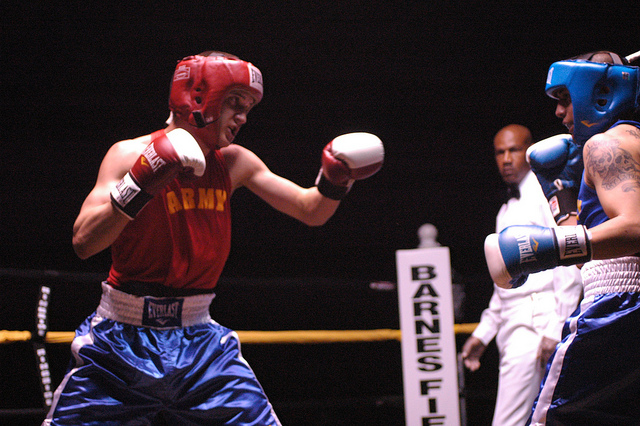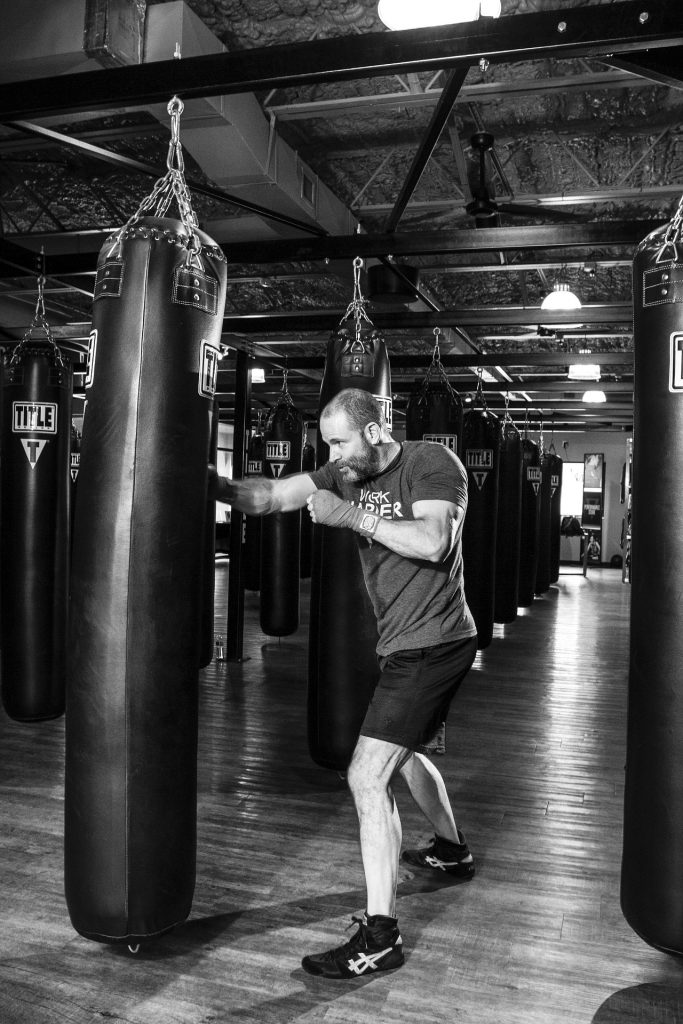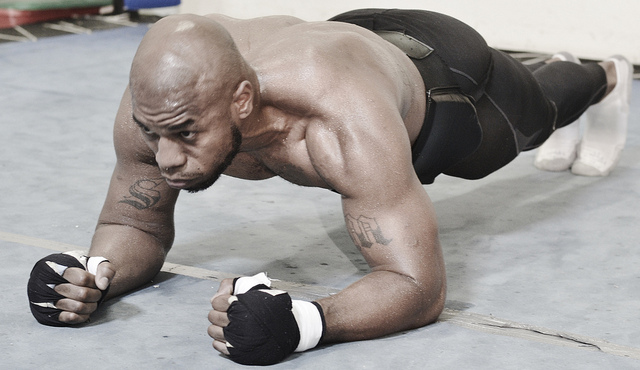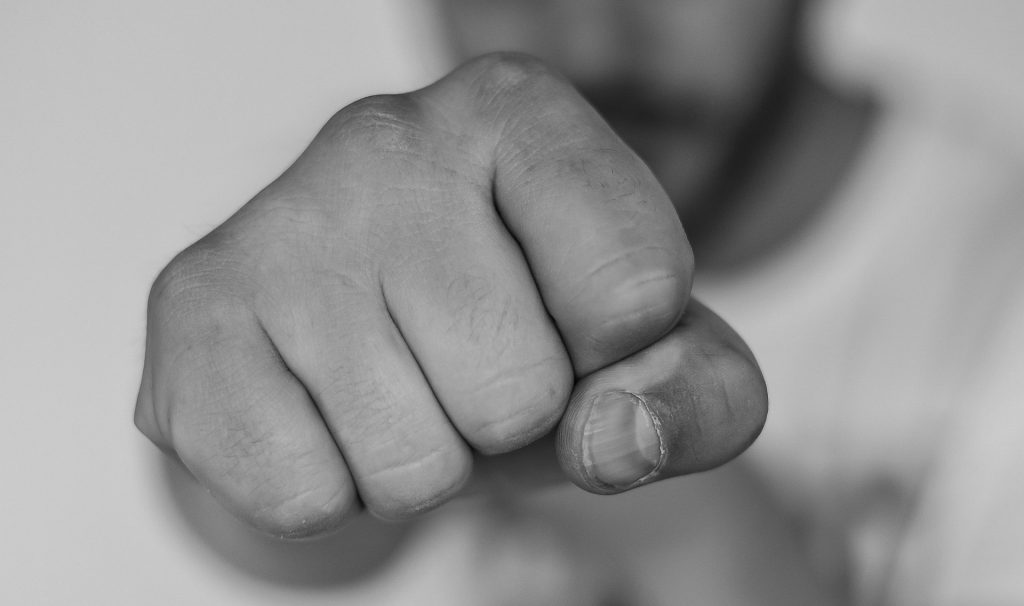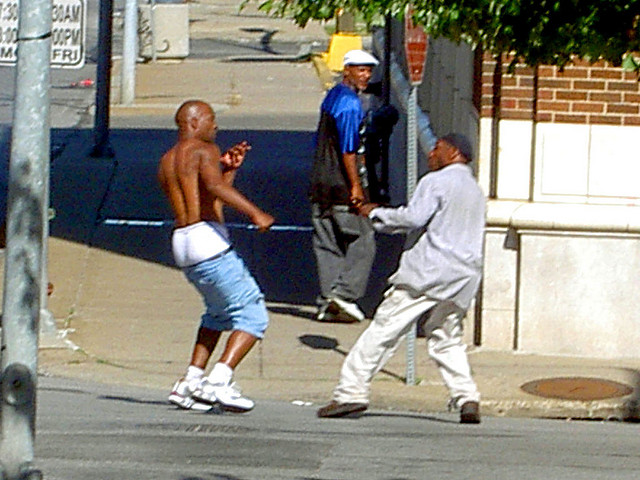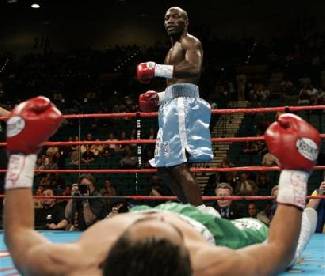As an attacker, throwing one perfect punch by itself can be effective but punches delivered in vollies of two, three, four, five, six or more become totally devastating.
As a defender, you can block, duck, or slip one punch fairly easily, but you'll have problems getting out of the way of five incoming, well thrown punches in sequence.
That specific sequence of punches forms a boxing combination. Boxers start by learning to throw individual punches but quickly progress to training that incorporates boxing combinations instead of single shots. Boxing combinations become the default attack and counter attack response and many trainers go as far as reprimanding their boxers for throwing a single jab in a fight or sparring situation.
Combinations take skill, stamina, and discipline to defend against and deliver. Just as you will train and prepare to throw combinations at your opponents, your opponents are training to throw them right back at you. Always expect a flurry of punches and when your opponent is unleashing combinations on you, you have to find the opportunity early to disrupt their flow and counter attack with a combination of your own.
As an attacker, throwing one perfect punch by itself can be effective but punches delivered in vollies of two, three, four, five, six or more become totally devastating.
As a defender, you can block, duck, or slip one punch fairly easily, but you'll have problems getting out of the way of five incoming, well thrown punches in sequence.
That specific sequence of punches forms a boxing combination. Boxers start by learning to throw individual punches but quickly progress to training that incorporates boxing combinations instead of single shots. Boxing combinations become the default attack and counter attack response and many trainers go as far as reprimanding their boxers for throwing a single jab in a fight or sparring situation.
Combinations take skill, stamina, and discipline to defend against and deliver. Just as you will train and prepare to throw combinations at your opponents, your opponents are training to throw them right back at you. Always expect a flurry of punches and when your opponent is unleashing combinations on you, you have to find the opportunity early to disrupt their flow and counter attack with a combination of your own.
You're Not That Good...
You're Not That Good...
You cannot possibly hope to slip or block every incoming punch and the more punches you let your opponent throw in the combination, the more likely one or more of them will connect. And when one does connect it raises the likelihood that the remaining punches in the combination will connect as well.
Once your opponent defeats your defense he or she seizes the initiative and can use the remaining punches in that combination to wreak havoc.
Let's consider the well-known 1-2 (jab, straight right). If your opponent lands a jab on you you are likely going to be momentarily stunned and your head may even get knocked back exposing your chin. The straight right immediately follows the jab and if it's timed correctly it's hitting that exposed chin or at very least connect somewhere as it follows the opening provided by the jab.
That's why it's important to nullify or counter attack as early into a combination as possible.
You can theoretically throw hundred punch boxing combinations over and over if you had perfect form and unlimited energy.
The next punch in a combination launches from the end position of the punch that happens before it requiring that you throw each punch, including recovery, correctly. Your technical form from beginning to end of your punch has to be perfect so that you are never off balance and your weight is positioned to allow for the next punch in the sequence.
This takes practice and attention to detail and your level of conditioning becomes very important. Boxing combinations require you to expend tremendous amounts of energy as you move through the sequence. You should be doing the proper boxing training to ensure you can last a whole fight whether it is one round or twelve.
You can theoretically throw hundred punch boxing combinations over and over if you had perfect form and unlimited energy1.
The next punch in a combination launches from the end position of the punch that happens before it requiring that you throw each punch, including recovery, correctly. Your technical form from beginning to end of your punch has to be perfect so that you are never off balance and your weight is positioned to allow for the next punch in the sequence.
This takes practice and attention to detail and your level of conditioning becomes very important. Boxing combinations require you to expend tremendous amounts of energy as you move through the sequence. You should be doing the proper boxing training to ensure you can last a whole fight whether it is one round or twelve.
Let It Flow...
Let It Flow...
Boxing combinations flow. They are never awkward to perform as long as all the punches are performed in sequence and with technical precision.
Boxing combinations feel right when you deliver them correctly, and it is because your weight is shifting and setting you up for every punch in the combination.
Going back to the 1-2 combination - imagine throwing a jab. You throw out the jab and your left hand is far forward hitting your target. When throwing the jab you torqued your left hip clockwise (for orthodox fighters) to give your jab a little extra power. The position you are in at that moment of impact sets you up perfectly to throw a hard straight right because as you recover your hips and jab arm back into your guard, you've already started the counter-clockwise torque of your hips required to throw the straight right.
From there, let the momentum carry you and you start to transfer weight to your left leg, continue the torque of your hips and thrust your right fist to the same location your left was just at to complete the straight right motion and impacting on target milliseconds after the jab.
Taking that further - notice how your weight and body is now setup and in perfect position to throw a left hook to bring your weight back to the right.
Boxing combinations flow. They are never awkward to perform as long as all the punches are performed in sequence and with technical precision.
Boxing combinations feel right when you deliver them correctly, and it is because your weight is shifting and setting you up for every punch in the combination.
Going back to the 1-2 combination - imagine throwing a jab. You throw out the jab and your left hand is far forward hitting your target. When throwing the jab you torqued your left hip clockwise (for orthodox fighters) to give your jab a little extra power. The position you are in at that moment of impact sets you up perfectly to throw a hard straight right because as you recover your hips and jab arm back into your guard, you've already started the counter-clockwise torque of your hips required to throw the straight right.
From there, let the momentum carry you and you start to transfer weight to your left leg, continue the torque of your hips and thrust your right fist to the same location your left was just at to complete the straight right motion and impacting on target milliseconds after the jab.
Taking that further - notice how your weight and body is now setup and in perfect position to throw a left hook to bring your weight back to the right.
Keep it Stable...
Keep it Stable...
When throwing combinations you shouldn't have to move your feet. Maintain a grounded base to generate the power needed to control the weight transfer that is happening throughout the combination. Your choice of punches will allow you to shift your weight and maintain balance until you choose to end the combination and move to a new attack position.
If you have to take a step, you did something wrong, because your weight ended up shifting too far or not far enough to allow you to deliver the next punch.
That's not to say you will never have to adjust your position while delivering combinations. It is highly unlikely your opponent will just stand there and let you beat on him. If he does - take advantage of it and consider yourself lucky.
In boxing - amateur and professional - the more punches you throw, the more will connect, the more damage will be done to your opponent, the more points you will score, and the more matches you will win. Obviously throwing combinations will help out in that goal.
So you want a list of boxing combinations?
So you want a list of boxing combinations?
When throwing combinations you shouldn't have to move your feet. Maintain a grounded base to generate the power needed to control the weight transfer that is happening throughout the combination. Your choice of punches will allow you to shift your weight and maintain balance until you choose to end the combination and move to a new attack position.
If you have to take a step, you did something wrong, because your weight ended up shifting too far or not far enough to allow you to deliver the next punch.
That's not to say you will never have to adjust your position while delivering combinations. It is highly unlikely your opponent will just stand there and let you beat on him. If he does - take advantage of it and consider yourself lucky.
In boxing - amateur and professional - the more punches you throw, the more will connect, the more damage will be done to your opponent, the more points you will score, and the more matches you will win. Obviously throwing combinations will help out in that goal.
Recap of Punch Numbering. B following a number refers to body shot.
- 1-Jab
- 2-Straight Right
- 3-Left Hook
- 4-Right Hook
- 5-Left Uppercut
- 6-Right Uppercut
There are potentially hundreds and thousands of combinations depending on how well conditioned you are and once you understand how they work you can come up with your own. But in the beginning you must master the basics.
Start with the four fundamental boxing combinations below and then move on from there. At some point, the essence behind boxing combinations will click in your head and you will understand why one punch follows the one before it. At that point you should be able to make up your own combinations.
There are potentially hundreds and thousands of combinations depending on how well conditioned you are and once you understand how they work you can come up with your own. But in the beginning you must master the basics.
Start with the four fundamental boxing combinations below and then move on from there. At some point, the essence behind boxing combinations will click in your head and you will understand why one punch follows the one before it. At that point you should be able to make up your own combinations.
How to Learn Boxing Combinations
How to Learn Boxing Combinations
Attach combination use to a trigger. You have to visualize when and how you would use this combination in a fight so you can train your mind to subconsciously recognize when the conditions are right to use it. If you have to think about when to use it - you've already missed your opportunity.
Visualizing triggers is harder to do on the offence than the defense. On the defense, your trigger is usually your response to a punch from from your opponent. For example - if you elbow block a body shot to your right side (orthodox boxers), that is your trigger to immediately throw a 6-3-2. Elbow block on the left side of your body = 5-2-3.
Once you identify a combination you want to learn, you have to drill it until you no longer have to think about it to throw it. It's all fine and good to start off thinking to yourself - 1-2, 1-2-3, 2-3-2 - but every time you think about what punch comes next you lose that split second and your timing gets messed up. Once you start a combination you throw it to completion and it eventually becomes a punch of its own. You can even name them if you like.
If you've taken the time to drill these boxing combinations to the point of perfection, then when a target opens up, the combination will instantly flow out when you need it.
When trying to learn new combinations - do one at a time.
Why you ask?
Because if you don't you will end up with a bunch of imperfect combinations and none that really work well. They won't turn into punches of their own and they'll never really do what they are designed to do.
When learning a boxing combination, learn it in this sequence for the best results:
- Focus on the technique of the combination. Don't start drilling it and throwing for speed until you have the technique and transition between each punch relatively perfect. Pay attention to everything - position, hand position, weight distribution, head position, and so on. This is where bad habits will creep in and bad habits form flaws in your combination that your opponent can use to disrupt your flow.
On the offense you have to visualize how your opponent might be setup that would make your combination effective. It might be that their front hand falls to shoulder height resulting in a 1-2. Maybe you visualize the front hand rising up as a trigger to go 3B-3H-2.
- Drill it till you're sick of it. Dedicate entire rounds to one combination. Throw it over and over and over and over and over and over again. Get the picture? Do not mix other combinations in with it. You have to teach your muscles to work in a certain order for each combination and it has to come out as a reflexive action. Visualize the trigger - throw the combination - recover and move. Visualize the trigger - throw the combination - recover and move.
Once you've learned a combination to the point of it being instinctual you won't have to drill it as much but you can't forget it either. From time to time it should be a part of your training plan so you can prevent skill fade and keep the instinct alive and well.
Once you identify a combination you want to learn, you have to drill it until you no longer have to think about it to throw it. It's all fine and good to start off thinking to yourself - 1-2, 1-2-3, 2-3-2 - but every time you think about what punch comes next you lose that split second and your timing gets messed up. Once you start a combination you throw it to completion and it eventually becomes a punch of its own. You can even name them if you like.
If you've taken the time to drill these boxing combinations to the point of perfection, then when a target opens up, the combination will instantly flow out when you need it.
When trying to learn new combinations - do one at a time.
Why you ask?
Because if you don't you will end up with a bunch of imperfect combinations and none that really work well. They won't turn into punches of their own and they'll never really do what they are designed to do.
When learning a boxing combination, learn it in this sequence for the best results:
- Focus on the technique of the combination. Don't start drilling it and throwing for speed until you have the technique and transition between each punch relatively perfect. Pay attention to everything - position, hand position, weight distribution, head position, and so on. This is where bad habits will creep in and bad habits form flaws in your combination that your opponent can use to disrupt your flow.
Attach combination use to a trigger. You have to visualize when and how you would use this combination in a fight so you can train your mind to subconsciously recognize when the conditions are right to use it. If you have to think about when to use it - you've already missed your opportunity.
Visualizing triggers is harder to do on the offence than the defense. On the defense, your trigger is usually your response to a punch from from your opponent. For example - if you elbow block a body shot to your right side (orthodox boxers), that is your trigger to immediately throw a 6-3-2. Elbow block on the left side of your body = 5-2-3.
On the offense you have to visualize how your opponent might be setup that would make your combination effective. It might be that their front hand falls to shoulder height resulting in a 1-2. Maybe you visualize the front hand rising up as a trigger to go 3B-3H-2.
- Drill it till you're sick of it. Dedicate entire rounds to one combination. Throw it over and over and over and over and over and over again. Get the picture? Do not mix other combinations in with it. You have to teach your muscles to work in a certain order for each combination and it has to come out as a reflexive action. Visualize the trigger - throw the combination - recover and move. Visualize the trigger - throw the combination - recover and move.
Once you've learned a combination to the point of it being instinctual you won't have to drill it as much but you can't forget it either. From time to time it should be a part of your training plan so you can prevent skill fade and keep the instinct alive and well.
The Four Basic Boxing Combinations You Must Know
The Four Basic Boxing Combinations You Must Know
1-1 or 1-1-1 (Double Jab and Triple Jab)
1-1 or 1-1-1 (Double Jab and Triple Jab)
So, a 1-1 is two jabs, a 1-1-1 is three jabs.
These combinations are an effective way to throw a bunch of punches from a distance. It is imperative you recover completely after each jab so subsequent jabs are delivered effectively and accurately.
So, a 1-1 is two jabs, a 1-1-1 is three jabs.
These combinations are an effective way to throw a bunch of punches from a distance. It is imperative you recover completely after each jab so subsequent jabs are delivered effectively and accurately.
1-2 (The Jab Straight Right Combo)
1-2 (The Jab Straight Right Combo)
One of the most important and famous of all combinations, the mighty 1-2. In this, you throw a jab which closes the distance and sets up the head for the power punch of the straight right delivered right after.
The objective with the jab is to snap your opponent's head back with your jab which exposes his chin. You then nail him with a right sending him to the mat. Throughout the whole sequence, you should feel firm on your feet, never off balance. If you do, you're not doing something right. It's one of two things, you are either reaching for the opponent or not recovering completely from your punches.
One of the most important and famous of all combinations, the mighty 1-2. In this, you throw a jab which closes the distance and sets up the head for the power punch of the straight right delivered right after.
The objective with the jab is to snap your opponent's head back with your jab which exposes his chin. You then nail him with a right sending him to the mat. Throughout the whole sequence, you should feel firm on your feet, never off balance. If you do, you're not doing something right. It's one of two things, you are either reaching for the opponent or not recovering completely from your punches.
1-2-3 (The Jab, Straight Right, Left Hook Combo)
1-2-3 (The Jab, Straight Right, Left Hook Combo)
The other most important combination (good english eh), jab/straight right/left hook. This basically completes the 1-2.
Same objective for the first two punches, jab the head to expose the chin, nail the chin with the straight right. This creates a weight transfer to the left side which automatically sets you up to land a devastating left hook. Your target for the left hook is the right temple of your opponent - clobber it.
The other most important combination (good english eh), jab/straight right/left hook. This basically completes the 1-2.
Same objective for the first two punches, jab the head to expose the chin, nail the chin with the straight right. This creates a weight transfer to the left side which automatically sets you up to land a devastating left hook. Your target for the left hook is the right temple of your opponent - clobber it.
2-3-2 and 3-2-3 (The Right Left Right and Left Right Left Combo)
2-3-2 and 3-2-3 (The Right Left Right and Left Right Left Combo)
The right-left-right and the opposite left-right-left. The goal here is to time the weight shifts correctly. With every punch you throw, it should set you up nicely for the subsequent punch. The right shifts the weight over the left which is perfect for the left hook which subsequently puts the weight back over the right which naturally makes you want to throw the right again.
The challenge here is to ensure you are not just throwing a flurry of arm punches. You must get your body involved because that is where the power comes from. You'll devastate your opponent as you attack from two different angles (side/front).
That's part of the beauty of combinations. Delivered correctly, punches start hitting you from all different angles. It makes defense that much harder.
Perfecting these combinations will take some time but make sure you do, they are all natural and like all combinations must flow. You'll have a pretty good indication when you are doing them right because it will simply feel right, not to mention the power of your punches will increase.
The use of combinations while extremely effective, also requires extreme caution. It is easy to forget to recover after each punch or get sloppy in your technique. If you over expose yourself you can expect your opponent to disrupt your flow and you can kiss a few more brain cells bye bye.
The right-left-right and the opposite left-right-left. The goal here is to time the weight shifts correctly. With every punch you throw, it should set you up nicely for the subsequent punch. The right shifts the weight over the left which is perfect for the left hook which subsequently puts the weight back over the right which naturally makes you want to throw the right again.
The challenge here is to ensure you are not just throwing a flurry of arm punches. You must get your body involved because that is where the power comes from. You'll devastate your opponent as you attack from two different angles (side/front).
That's part of the beauty of combinations. Delivered correctly, punches start hitting you from all different angles. It makes defense that much harder.
Perfecting these combinations will take some time but make sure you do, they are all natural and like all combinations must flow. You'll have a pretty good indication when you are doing them right because it will simply feel right, not to mention the power of your punches will increase.
The use of combinations while extremely effective, also requires extreme caution. It is easy to forget to recover after each punch or get sloppy in your technique. If you over expose yourself you can expect your opponent to disrupt your flow and you can kiss a few more brain cells bye bye.
The Commando Boxing System of Boxing Combinations
The Commando Boxing System of Boxing Combinations
You can use the boxing combination system taught in the Commando Boxing online boxing club to amass a virtually unlimited number of combinations and learn how to form your own.
The system is based on the number of types of punches used in a combination. They form the basis of a series of boxing combinations, there are seven series in total, and you can daisy chain them together:
A 1 Series combination is one that uses one type of punch (1-1, 1-1-1 for example). 2 Series = two types of punches (1-2, 1-2-1-2, 2-3, 3-2, for example). 3 Series = three types of punches and so on.
You can use the boxing combination system taught in the Commando Boxing online boxing club to amass a virtually unlimited number of combinations and learn how to form your own.
The system is based on the number of types of punches used in a combination. They form the basis of a series of boxing combinations, there are seven series in total, and you can daisy chain them together:
A 1 Series combination is one that uses one type of punch (1-1, 1-1-1 for example). 2 Series = two types of punches (1-2, 1-2-1-2, 2-3, 3-2, for example). 3 Series = three types of punches and so on.
In Summary
In Summary
Personally I learn better when I understand the reasoning behind why something is done which is why I took the time to explain the theory behind boxing combinations rather than just give you a list of combinations to go learn. Maybe you don't care and just want the list - that's fine - whatever works for you. At any rate you should have a little more insight into how boxing combinations will make you a more effective boxer (or burn more calories if you're just using boxing workouts for fitness reasons).
That's the end of part one of this boxing combination series and focused primarily on how to throw boxing combinations. Part two will take a look at how to defend against boxing combinations to disrupt attacks early and take the initiative from your opponent. Until next time - Boxon.
P.S. Do you have a favorite boxing combination? Take a second a share it as a comment.
Personally I learn better when I understand the reasoning behind why something is done which is why I took the time to explain the theory behind boxing combinations rather than just give you a list of combinations to go learn. Maybe you don't care and just want the list - that's fine - whatever works for you. At any rate you should have a little more insight into how boxing combinations will make you a more effective boxer (or burn more calories if you're just using boxing workouts for fitness reasons).
That's the end of part one of this boxing combination series and focused primarily on how to throw boxing combinations. Part two will take a look at how to defend against boxing combinations to disrupt attacks early and take the initiative from your opponent. Until next time - Boxon.
P.S. Do you have a favorite boxing combination? Take a second a share it as a comment.




